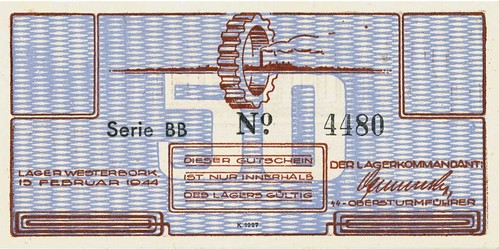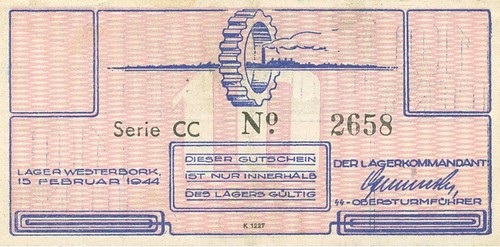
PREV ARTICLE
NEXT ARTICLE
FULL ISSUE
PREV FULL ISSUE
WESTERBORK CENTRAL REFUGEE CAMP SCRIPHere's a Google-translated article from Geldschiene-Online by Hans-Ludwig Grabowski about the "Jewish transit camp" Westerbork and its paper money. Found via News & Notes from the Society of Paper Money Collectors (Volume VI, Number 40 March 23, 2021). -Editor 
In mid-December 1938, the Netherlands closed its borders to refugees from the German Reich in the interests of friendly relations with its German neighbors. From this point on, they were neither welcome nor should they be integrated. In February 1939, the Dutch government decided to build a reception center near Westerbork to accommodate the mainly Jewish refugees. A first group arrived here on October 9, 1939. When German troops marched into the Netherlands on May 10, 1940 to “protect Dutch neutrality” and to prevent British forces from landing on the continent, around 700 people were in the “Central Refugee Camp Westerbork”. The "Kamp Westerbork" was taken over by the German occupation and continued utilized. German Jews arrested or volunteered in the Netherlands were arrested. After the decision was made at the end of 1941 to use Westerbork as the central transit camp for the mass deportation of Dutch Jews, the camp was placed under the command of the Security Police and the Security Service (BdS) on July 1, 1942, and became the "Police Jewish Transit Camp" In 1943/1944, various workshops were set up in which the prisoners had to work until they were deported, including a tailor's shop, a linoleum factory and the "storage industry" in which aircraft, apparatus, batteries and cables are dismantled and metals, foils and waste are sorted for recycling were. The appearance of normalcy was preserved in the camp itself. The reign of terror common in concentration camps was largely dispensed with, there was a school, a hospital and an orphanage, sporting events and even an orchestra of its own. Instead of Kapos and SS, Westerbork had its own Jewish police with the security service, which is also known from ghettos. The last transport left Westerbork on September 13, 1944 with 279 people in the direction of Bergen-Belsen. Ten days earlier, Anne Frank, who became world-famous through her diary and a symbolic figure for the victims of the Holocaust, had also left Westerbork on the way to Bergen-Belsen, where she died of typhus in early March 1945.
Vouchers from the Westerbork camp 

The front of the notes shows the warehouse designation and the face value, a logo with a gear wheel as a symbol of work. On the back there is a view of the warehouse in the negative pressure. All values ??were produced in three series (AA, BB and CC) at the Van de Kamp print shop in Groningen (printer identification K 1227). Design and colored printing (overprint and underprint) are comparatively complex and modern, but this is also known from the other Dutch camps. The back shows a view of the warehouse with a warehouse road and a smoking chimney. Individual print samples and unfinished notes as well as misprints (e.g. with shifted print on the back) and incorrect cuts are known of the Westerbork storage money. After the liberation of the camp, prisoners took several hundred series of used notes with them. About 20 years ago these came onto the collector's market, which is why they are not unusually rare today.
To read the complete article, see:

Wayne Homren, Editor The Numismatic Bibliomania Society is a non-profit organization promoting numismatic literature. See our web site at coinbooks.org. To submit items for publication in The E-Sylum, write to the Editor at this address: whomren@gmail.com To subscribe go to: https://my.binhost.com/lists/listinfo/esylum All Rights Reserved. NBS Home Page Contact the NBS webmaster 
|